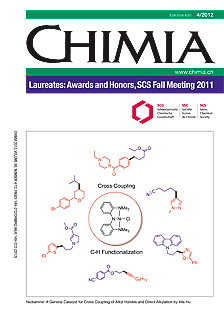High Spatial Resolution Quantitative Imaging by Cross-calibration Using Laser Ablation Inductively Coupled Plasma Mass Spectrometry and Synchrotron Micro-X-ray Fluorescence Technique
DOI:
https://doi.org/10.2533/chimia.2012.223Keywords:
High spatial resolution, La-icpms, Microxrf, Opalinus clay, QuantitativeAbstract
High spatial resolution, quantitative chemical imaging is of importance to various scientific communities, however high spatial resolution and robust quantification are not trivial to attain at the same time. In order to achieve microscopic chemical imaging with enhanced quantification capabilities, the current study links the independent and complementary advantages of two micro-analytical techniques – Synchrotron Radiation-based micro X-ray Fluorescence (SR-microXRF) and Laser Ablation Inductively Coupled Plasma Mass Spectrometry (LA-ICPMS). A cross-calibration approach is established between these two techniques and validated by one experimental demonstration. In the presented test case, the diffusion pattern of trace level Cs migrating into a heterogeneous geological medium is imaged quantitatively with high spatial resolution. The one-dimensional line scans and the two-dimensional chemical images reveal two distinct types of geochemical domains: calcium carbonate rich domains and clay rich domains. During the diffusion, Cs shows a much higher interfacial reactivity within the clay rich domain, and turns out to be nearly non-reactive in the calcium carbonate domains. Such information obtained on the micrometer scale improves our chemical knowledge concerning reactive solute transport mechanism in heterogeneous media. Related to the chosen demonstration study, the outcome of the quantitative, microscopic chemical imaging contributes to a refined safety assessment of potential host rock materials for deep-geological nuclear waste storage repositories.Downloads
Published
2012-04-25
Issue
Section
Scientific Articles
License
Copyright (c) 2012 Swiss Chemical Society

This work is licensed under a Creative Commons Attribution-NonCommercial 4.0 International License.
How to Cite
[1]
Chimia 2012, 66, 223, DOI: 10.2533/chimia.2012.223.







